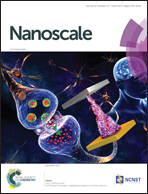A detour strategy for colloidally stable block-copolymer grafted MAPbBr3 quantum dots in water with long photoluminescence lifetime†
Abstract
Perovskite quantum dots (PQDs) exhibit remarkable photoluminescence properties; however, their use in biological applications is hindered by their extreme sensitivity to water. We report a facile and general strategy for the preparation of aqueous colloidally stable polystyrene-b-poly(ethyl oxide) (PS-b-PEO) grafted MAPbBr3 QDs (MA = methylammonium): transferring the as-synthesized PQD@PS-b-PEO from toluene into water using precipitation in hexane as a critical intermediate step. When rehydrating the precipitate in water, the PQDs can be dispersed well individually or self-assembled into well-defined vesicular nanostructures with high photoluminescence quantum yields of up to 43%, high color purity (full width at half maximum down to 18 nm), and long average photoluminescence lifetimes up to 164 ns. The resulting PQD nanostructures in water also show excellent thermo- and photo-stability, low cytotoxicity, and bright potential for cell imaging. This work highlights the future prospects of using polymer-modified PQDs with desired physicochemical properties for biomedical applications.

- This article is part of the themed collection: Nanoscale 10th Anniversary: Top Authors


 Please wait while we load your content...
Please wait while we load your content...